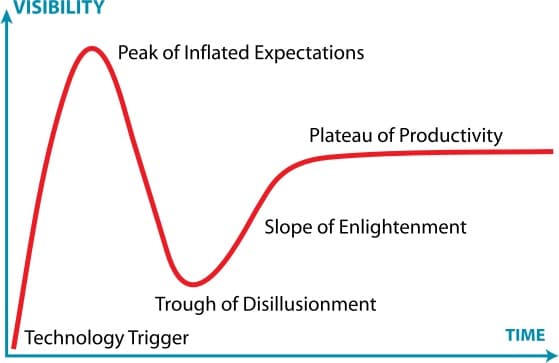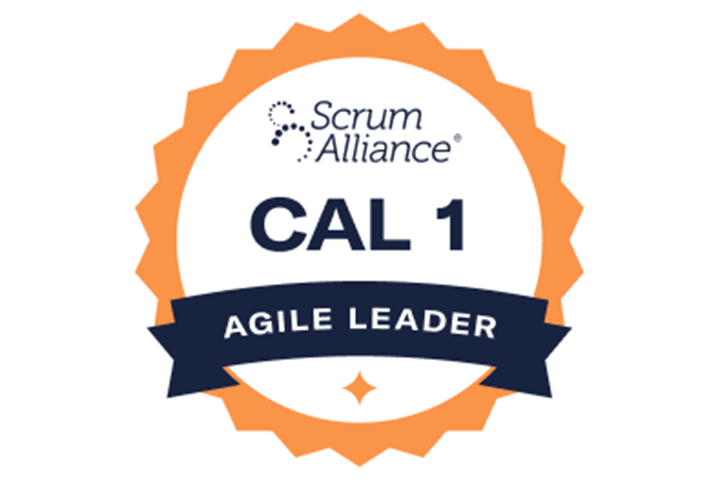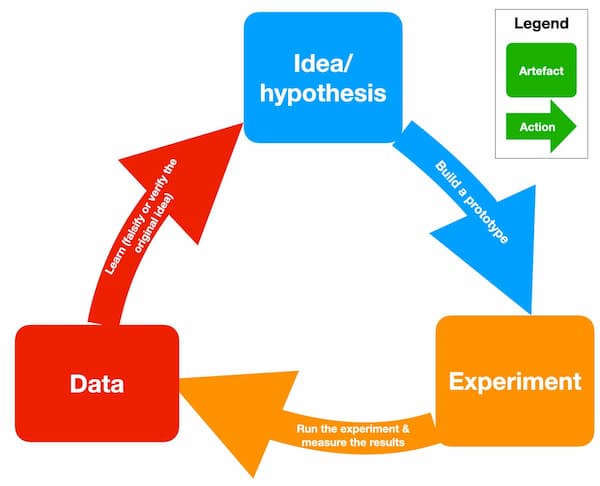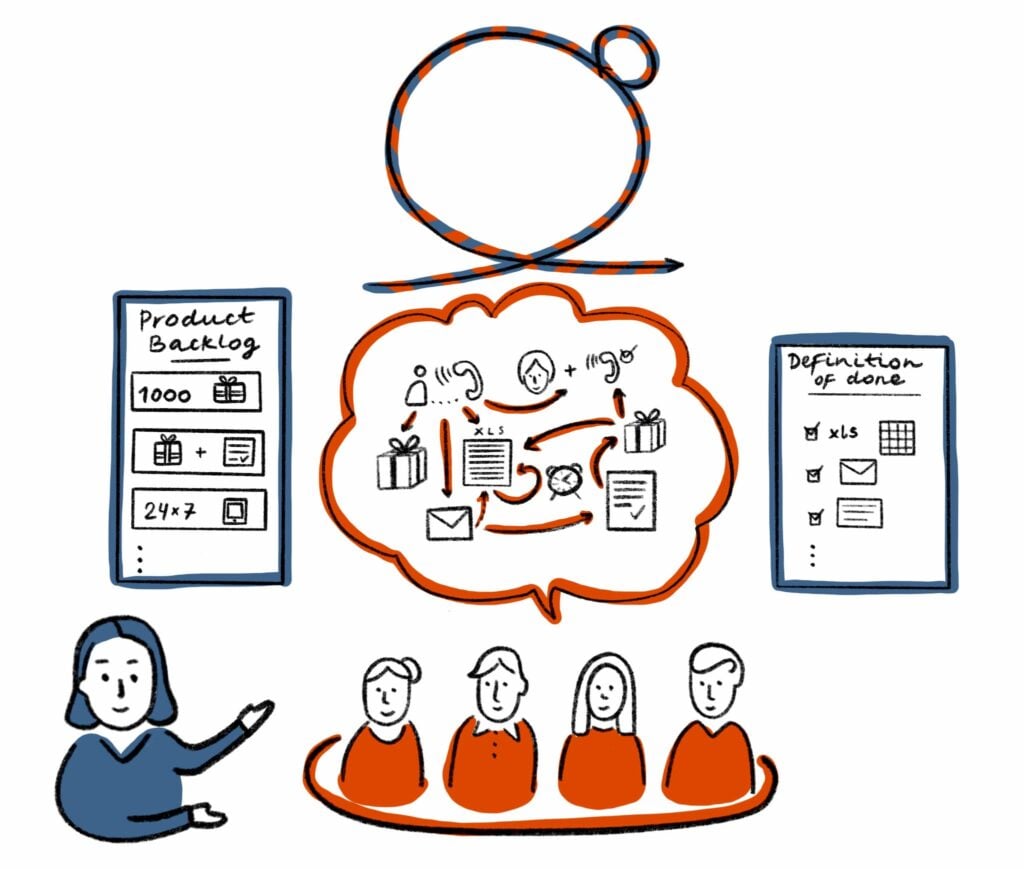What does Agile mean?
In this post, we explain the different meanings of the word Agile in 2021. Today, the term “Agile” and agile organizations are used in plenty of media and contexts. For some, it is considered a buzz word. Many coaches are critical about that because it washes out the meaning of the word. At the same time, it is also a kind of accolade for a movement when all big and small consulting organizations like (McKinsey, BCG, Deloitte, etc.) suddenly offer Agile transformations.

For the respective short explanation of a meaning of Agile click on what interests you in the table of contents below.
- What does Agile mean?
- Different terms and synonyms for Agile
- Agile: Definition and agile software Development
- Agile means self-organization & self-responsible work
- Economic meaning of Agile: Maximum Principle
- Agile means new kind of leadership and real coaching
- Agile means empirical work
- Agile also means technical excellence
- Agile means cross-functional work
- Agile means Scrum (or Kanban)
- Agile means digitization
- Agile Project Management – Definition
- Summary
Different terms and synonyms for Agile
Before you read on, take a moment to ask yourself. What do you associate with the word “Agile”? Here are some answers we hear over and over again:
- Motivated
- Self-reliant
- Adaptable
- Agile
- Quick
- Authentic or Honest
- Flexible
- Iterative, step by step
Below, we explain how Agile is related to each of these words.
Agile: Definition and agile software Development
Before we present the various meanings ‘agile’ takes on today, let’s look at the original definition of the term “Agile”. A look at the history of its origins often helps.
Before 2001, the adjective “agile” was used rather rarely in English. For example, when describing dogs: “agile dogs”. Then, in February, 17 experts, known at the time for popularizing the so-called “lightweight development methods”, met in Utah. Their intention was to come up with a new term and to formulate what they have in common. “Lightweight”, after all, is not adequate to describe the methods that were used to create the largest and most stable software platforms at the time.
Here’s what we gleaned from the personal narrative of Craig Larman, who was invited but not there himself: When it came time to vote for the term, there were several options on a flip chart. We know the winner – “agile.” The other terms that received the most votes were: “adaptive” in 2nd place and “flexible” in 3rd place.
The original definition of Agile is closest to the terms adaptive and flexible.
Everything these 17 leading experts in software development agreed upon at the time can still be found today at: http://agilemanifesto.org/. There are two things, the Agile Software Development Manifesto and the 12 principles behind it. Strictly speaking, these are the only things that can definitely be called Agile.

Agile means self-organization & self-responsible work
But the idea of Agile has become much more widespread and much less associated with software today. In fact, most people who approach us at Agile.Coach about Agile are hoping for more effective self-organization and self-responsibility in their organization.
The basic idea behind Agile is – and therein lies a common root with “The Toyota Way” (or “Lean” as it was christened by MIT scientists) – respect for people. Building the work system in a way where leadership can trust their motivated people to be the best experts and make the best decisions for their projects.
Build projects around motivated individuals. Give them the environment and support they need, and trust them to get the job done.
Principle #5, Agile Software Development Manifesto
In fact, the various frameworks and agile methodology building blocks provide different approaches for people in an organization to gradually take on more responsibility and for leaders to become less tactical and more strategic in their decision-making.
Economic meaning of Agile: Maximum Principle
One of the reasons for today’s popularity of Agile is that this term hides various business practices that all have in common that they follow the economic maximum principle.
The minimum principle means achieving a fixed result with a minimum use of resources. This is achieved by optimizing processes and focusing on efficiency. This includes classic project management or 6-Sigma.
The maximum principle means to give oneself a fixed resource basis and thus to strive for a maximum result. If the end result is unclear, the minimum principle is not applicable. The ability to focus on what is best at the moment, deliver it quickly, and reorient, is what makes the most economic sense. This is exactly what such frameworks as: Lean StartUp, Effectuation, Hypothesis Driven Development and others, do. Here, the focus is on effectiveness (doing the right things) rather than efficiency (doing things with little resources).
Briefly, it should be mentioned that people often talk about the minimax principle – maximum result with minimum resources. This does not exist. In purely mathematical terms, you can only optimize one variable while keeping the constraints fixed.
Agile means new kind of leadership and real coaching
At first glance, there is no connection between the above paragraph about self-organization and the economic maximum principle. But if you look closer or try to implement it, the following becomes clear: To harvest effectiveness in a complex (or VUCA) world, the most important capability of an organization is to be adaptive. This brings us back to the original synonyms for the term Agile from the original namesakes.
This adaptability requires rapid information flow and decision-making. In a small organization, this is a given, regardless of the internal structure, because everything is clear. In large classical organizations with typical hierarchical decision-making structures, this speed is lost.
For this reason, agility means for many employees that they are expected to take responsibility in areas that they did not consider their own before. At the same time, for managers, this means learning to lead differently and, in particular, to adapt their leadership to the situation. Leaders learn to work more on the system, rather than within the system.
Example: When a project manager prepares a customer presentation by himself or makes decisions about the specific design of a product by himself, he is working within the system. There’s nothing wrong with that. Every employee has tasks in the system that he or she performs.
However, the higher the power in an organization, the more important the work on the system becomes. This means for the example above: How can I change the decision-making process and the framework conditions for designing the product in such a way that the people with the direct design competence can make as many decisions as possible themselves?

Certified Agile Leadership certification
Lean to lead in an organisation at change. Welcome to our Agile Leadership trainings.
In order to work on the system, you need skills such as: observing, listening, coaching, facilitating, and self-reflection.
Agile means empirical work
As indicated above, Agile organizations often make decisions faster. And something else is important. As Agile works in the complex unpredictable world, these decisions are not based on internal KPIs but on observations and measurements of one’s impact on the outside world.
We call this way of controlling one’s process – empiricism or empirical process control. This is exactly what stands behind the Build-Measure-Learn cycle of Lean StartUp or the PDCA (Plan-Do-Check-Adapt) Deming cycle.

For many organizations, learning to measure their impact means learning to do it purposefully and quickly. If all decisions depend only on annual sales, the earliest you will know if a product cycle was successful is a year after it was completed (often 3-7 years). That is too slow.
What helps here are reliable leading indicators on the one hand. At the same time, an organization must also learn to split its work differently. In a way that allows to measure real progress after a short time.
Agile also means technical excellence
The aforementioned ability to split up work comes with an important big consequence. Agile doesn’t just mean that the process of managing the work changes, but that – how we do our work – changes as well. We need to deliver partial products in short periods of time – we call them increments – that can have an impact. And these increments together have to make not a lot of little things but a coherent whole. This is a craft that everyone involved must learn. And this is an area that is not clear to many at the beginning of such a project.
An example – technical excellence in marketing campaigns:
Let’s imagine that we are used to planning our product for half a year before we deliver it. Let’s take a marketing campaign as a product example. This means that we discuss many global architecture decisions for a long time at the beginning and then make them firm. For example, at some point we decide to focus on advertising on TV and in magazines. Then all the rest of the work is planned: TV commercials shot and ads created. When these are delivered, we may realize, this early decision for TV was wrong. We would have achieved much more if we had relied on a social media campaign.
Incremental approach here would mean making small sub-campaigns and using them to test the effectiveness of different marketing channels. And in doing so, keep running and slowly building up the entire campaign.
In detail, this often means using different tools and standardizing interfaces, applying different working practices. Here: practices that allow quick switching from a TV spot to a Youtube spot to a magazine ad. These practices are what’s called technical excellence. And they differ depending on what you’re doing.
Agile means cross-functional work
In order to be able to quickly deliver the increments – partial campaigns – mentioned above, cross-functional teams are usually necessary. Experts, who otherwise only do their part and hand over documentation or specifications to each other, now work together as a team and take joint responsibility for the result. Joint or shared responsibility – is typically easier said than done and usually requires a coach. In the Scrum framework, we call this person – Scrum Master.
Agile means Scrum (or Kanban)
Even though the Agile Manifesto can be lived without them – there is a lot of knowledge and methods in the frameworks Scrum and Kanban to help an organization make the first steps towards agility. We have described each framework in detail, so just to briefly sum up:
Scrum helps among other things to
- establish and understand important feedback mechanisms and operating principles of self-organization.
- build minimal structure for self-organization, cross-functionality and effective delegation.
- Create clarity of roles and explicitly introduce the coach role (Scrum Master), which promotes team ownership and new leadership in the organization.

Kanban helps:
- to understand and visualize existing processes in knowledge work
- to identify and eliminate bottlenecks in processes
- Measure process results and achieve a balance between requirements and capacity.

Agile means digitization
For many organizations and also the state, Agile is only a side issue that is triggered by another issue – digitization. Digitization usually means that processes that were previously analog are now replaced by (partially) programmed processes.

Here, there are two sources of unpredictability at once and thus the need for Agile:
- On the one hand, the digitization of an organization directly creates software. Here, it is in the nature of things to rely on Agile methods. Software tools and requirements are constantly evolving. There is a lot of uncertainty in how the usage scenarios and interfaces should look and work.
- At the same time, most organizations find out that in detail, all theoretical processes, no matter how well described, always require exceptions to work in reality. There are places where manual adjustments have to be made and inconsistency has to be tolerated for a period of time. This means, that adaptability and changes are needed again and again.
In addition, when process regulations change, these changes must also be reflected in the software. All this calls for employees who understand their system themselves and can form cross-functional teams, core elements of Scrum.
Agile Project Management – Definition
Ken Schwaber, one of the founding fathers of Scrum, wrote the book “Agile Project Management with Scrum”. Therefore, we claim that the best definition of this controversial term – Agile Project Management is Scrum.

Ken himself is said to have declared it a mistake later. Nevertheless, this is exactly how it is (mis)understood by many people today. For many, the most difficulty is created by the self-evidence behind the term “project” as something limited in time.
Many dysfunctions in organizations have their origin in the fact that a long-term goal is broken down into short “projects”, each with different project leaders. This makes the whole process very inflexible. In addition, each individual sub-project tries to be “successful” for itself and accepts, for example, small quality deficiencies and suboptimal sub-aspects. For the long-term goal, these quality deficiencies and inappropriate sub-aspects often add up to an unusable end result. None of the “small” project managers is responsible for this large end result.
Summary
There are many factual reasons why adaptability is required of all organizations in today’s world. The term Agile is now used to describe various frameworks, practices, methodologies, approaches, and leadership approaches that support an organization’s adaptability.